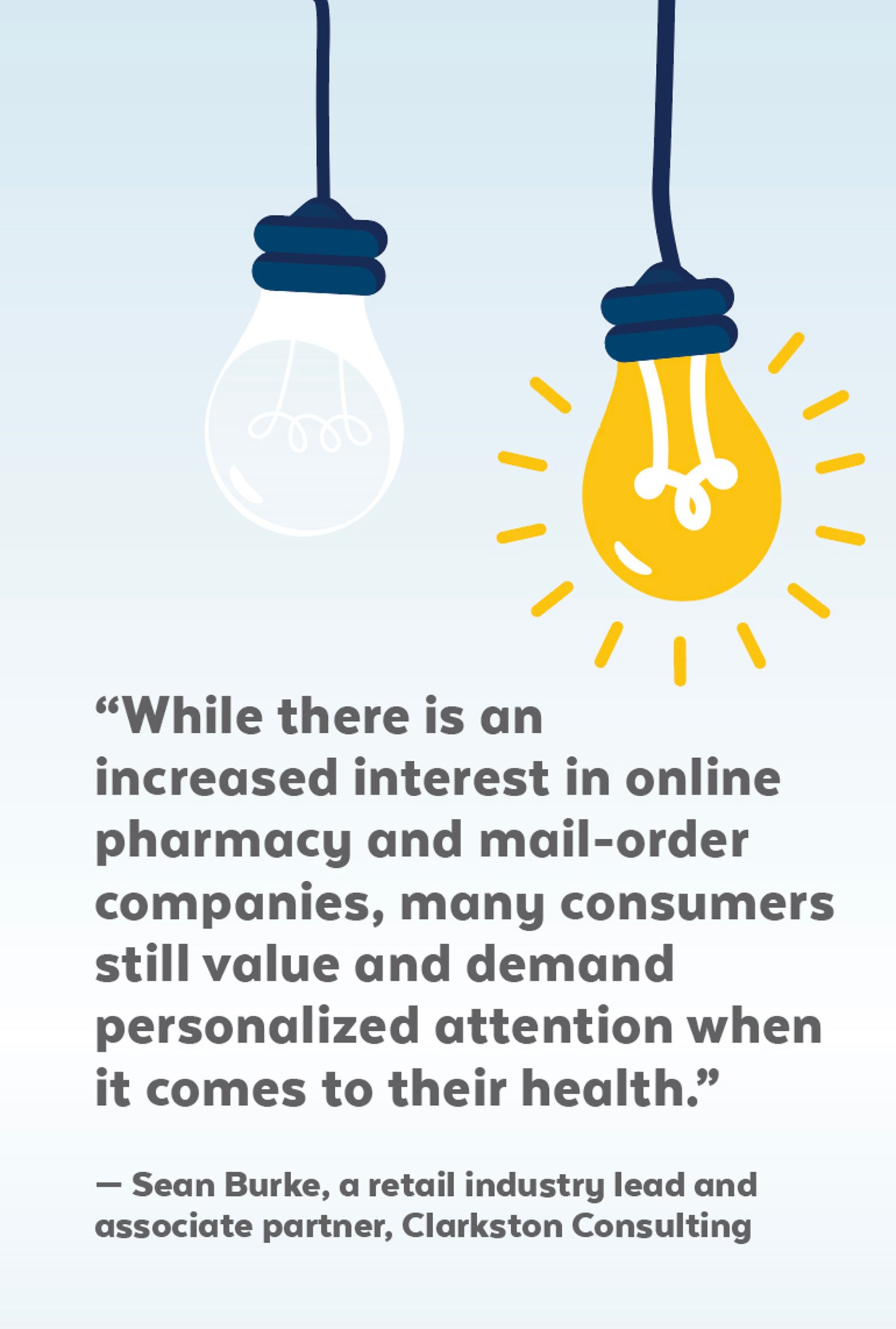Industry experts offer big ideas
The challenges facing retail pharmacy, including increasing competition from e-commerce players and the need to drive store visits, are expected to linger through 2022 and beyond.
In addition, drug store operators are faced with immediate challenges around the tight labor market, as many workers may have either dropped out of the workforce or found employment that does not involve interacting with the public, said Julie Utterback, senior equity analyst, healthcare, at Morningstar Research Services. As a result, retailers may be paying higher wages, which could impact profit margins, she said.
“In terms of opportunities, we see many major retail pharmacies, like CVS and Walgreens, broadening their offerings into healthcare services, which we view positively,” Utterback said. “Continued growth in services could increase the productivity of their ubiquitous store footprints — an area of differentiation for the retailers versus local primary care physicians and competing managed care organizations — and make the stores an even more integral part of the U.S. healthcare system.”
If foot traffic declines as the COVID-19 pandemic eases, retailers could benefit from accelerating the pace of transitioning their stores to provide more healthcare services, she said.
Following are some other big ideas from industry experts about how retail pharmacies can prepare for the future.
Loyalty, Convenience and Personalized Service
Sean Burke, a retail industry lead and associate partner at Clarkston Consulting, suggested that as telehealth and online pharmacies remain viable options for most consumers, drug stores need to identify ways to establish customer trust and loyalty.
“Loyalty and reward programs are a great avenue for this,” Burke said, noting that drug store retailers can go beyond the “spend more, get more” approach.
[Read More: Products to Watch: HRG’s 5 picks from February 2022]
“To further encourage a healthy lifestyle, drug stores could award points or rewards for consumers achieving certain fitness milestones, like hitting a step goal or sleeping a set number of hours,” Burke said. “These same programs also offer more than simple coupons or discounts but find ways to provide unique experiences, products and services that make sense based on the brand characteristics and mission.”
Making prescription pickup more convenient has also become important, as options, such as buy online/pick up in store, curbside pickup and same-day delivery, have grown in popularity, he said.
“With more and more people working from home, brick-and-mortar drug stores will face a real challenge if they can’t compete in the digital landscape and put their product in the consumer’s hands faster,” Burke said.
While drug stores have long offered drive-thru lanes, they need to make in-store pickup even more convenient with amenities such as pickup lockers or kiosks. In addition, offering designated curbside pickup locations outside the stores can allow multiple people to check in at a given time.
Burke suggested retailers should also look at investing in a partnership with a delivery service to support same-day delivery as CVS has done with Shipt.
Focusing on the personalized customer experiences that pharmacists provide represents another big idea for drug stores, he said. When patients come in to pick up their medication or receive a vaccine, the pharmacist might be the only direct contact the customer has.
“While there is an increased interest in online pharmacy and mail-order companies, many consumers still value and demand personalized attention when it comes to their health,” he said. “If drug stores market themselves as consumer-centric and emphasize the role that a pharmacist plays in the customer experience, they are establishing a sense of trust and loyalty amongst their consumers — a true competitive advantage.”
Rethink Assortments and Inventory
Inna Kuznetsova, CEO of 1010data, a provider of analytical intelligence to the financial, retail and consumer markets, said the company’s recent E-Commerce Health & Wellness Spotlight report suggested a dramatic shift in the way consumers buy OTC pharmaceuticals.
“From the data we examined, we noted a clear opportunity for chain pharmacies to grow their share in certain OTC categories, and our findings illustrated the importance to chain drug retailers of having channel-specific marketing strategies tailored to both the online and offline consumer,” she said.
Drug stores should also take a close look at their inventory management, product assortments and merchandising to ensure that their offerings are optimized to drive foot traffic, Kuznetsova said.
“Rethinking demand planning to ensure that they carry the right inventory with faster turnover, sharing intelligence with their CPG providers to collaborate better around stock-ins and assortments, and personalizing promotions are just some things the pharmacies can do,” she said.
Kuznetsova cautioned that e-commerce is here to stay and will continue to grow, as consumers have grown accustomed to the convenience and as providers have improved their capabilities. Drug stores will continue to see competition from online pharmacies and e-sellers of health and beauty products, she said.
“It is time for the drug stores to rethink their business models by becoming the healthcare centers of the community, rewiring their supply chain planning and monetizing data by sharing it with CPG providers,” Kuznetsova said.
[Read More: Leading ladies: The rise of the female pharmacy executive has begun]
Put the Patient First
Eyad Farah, president of McKesson’s Health Mart and Health Mart Atlas, said retailers need to rethink their business around serving patient needs.
“For nearly 200 years, pharmacy engagement has been about the customer walking up to the counter to pick up their prescription,” he said. “That’s still the interaction that most people think of when you say the word ‘pharmacy.’ I challenge us to think boldly because in this scenario, the pharmacy is the center of the equation — not the patient.”
Retail pharmacies going forward must reimagine how they engage their patients, Farah said.
“It should be about more than the prescription,” he said. “Each pharmacy should provide services to patients at the top of their license.”
This includes interpreting lab results, providing diagnostic testing and telehealth services, tracking with digital wearables, stocking the right medical surgical items and vitamins, and even supporting patient mental health, which has taken on increased importance during the pandemic.
“We can do a lot more for patients,” Farah said. “So, my bold idea is to tailor your business to meet those needs. The boldest move we can make is to push our pharmacy operations beyond the prescription to surround the patient, utilizing pharmacy team training, education and experience … to provide services to patients.”
Use Technology to Improve the Customer Experience
Leslie Lotano-Saba, vice president of pharmacy solutions at AArete, a global management consultancy, suggested that retailers should challenge boards of pharmacy rules and others that are outdated and limit pharmacies’ ability to innovate.
Retailers also need to think about creating better working environments: “It’s stressful to see the pharmacist needing to multitask behind the counter,” she said.
Staffing shortages, illness and burnout could be a key challenge in the coming year, Lotano-Saba said. Along those lines, she also suggested that retail pharmacies:
- Embrace technology to automate tasks, identify and resolve insurance issues, etc., to free up pharmacists’ time so they can interact with patients and build the customer relationship;
- Consider adding a nurse in the pharmacy if needed, to free up pharmacists’ time to speak with patients;
- Use data analysis to proactively identify clinical issues that would benefit from a pharmacist intervention; and
- Use technology and digital tools to connect with customers — for example, using text messaging, telehealth and virtual care.
Coordinate In-store and Digital Services
Retail pharmacies need to find the right mix of in-store and online services and connect their brick-and-mortar and digital offerings, said George Van Antwerp, managing director at Deloitte Consulting, and author of a recent report called “The future of pharmacy — Disruption creates transformative opportunities and challenges.”
Antwerp said the industry is asking itself, “What’s the mix of physical with virtual, and how do we integrate so that we can be a front door to health? And how can we do that both virtually for some people and physically for other people?”
The answers, he said, may vary by patient, by the stage of their disease, by the pharmacy location and other factors. “That’s driving a very interesting discussion across the entire market to try to understand the different approaches to the retail store, and the different patient segments and customer journeys,” Van Antwerp said.
At the same time, he said, retail pharmacies need to consider how they will use data and technology to implement these services, how they will staff their stores to provide these services, and how they will seek reimbursement.
“In order for the pharmacist and the store to take on a broader role, they have to be able to collect and use data,” Van Antwerp said. “And it’s not only the data itself, but it’s the translation of that data into knowledge and ultimately into wisdom.”
Such a plan requires artificial intelligence or other analytics to help pharmacists understand the needs of each patient entering the pharmacy. Technology should be able to assist pharmacists in identifying gaps that may exist in a patient’s care, for example, or could suggest when it is appropriate to offer a particular screening or test.
[Read More: Getting creative with hiring and retention]
Pharmacies will also need to consider the labor-management tools that may be required to free up pharmacists for these kinds of activities. These could include centralized prescription-filling solutions or the use of predictive algorithms for refill patterns, for example, or the use of centralized call centers or digitized communications, he said.
Reimbursement, meanwhile, “requires a whole different way of looking at how they contract with payers and what their relationship is with the payer,” Van Antwerp said.
The industry has been making progress on the payment front, he said, citing the development of integrated networks that include pharmacies, hospitals and payers working together to better manage risk or provide care for patients with chronic disease or other complex care needs.
Other emerging areas where pharmacies can play a role are in remote patient monitoring and assisting patients in using at-home diagnostics. As more and more apps and devices that help patients manage their own health are introduced, pharmacists and technicians may be able to help patients use them correctly and understand test results, for example.
“I can Google anything, and all of a sudden I feel like I may be dying of some disease, but interpreting those results with context is something where I see a great role for the pharmacy and the pharmacist,” Van Antwerp said.
Sidebar: Three challenges facing retail pharmacy — and their possible solutions
Sean Burke, a retail industry lead and associate partner at Clarkston Consulting, outlined the following challenges facing retail pharmacy in the year ahead, and suggested solutions for each:
1. Adapting to hybrid retail
The traditional drug store retail model has been largely the same for several decades, so adapting to the new expectations of the modern shopper has been a challenge for drug stores. A digital-first approach and organizational mindset is critical to meeting the demands of the current market and realizing a hybrid model. Infrastructure is also key. Beginning with a digital technology core, and layering on the necessary data and analytics capabilities, are the first steps toward adopting a hybrid retail model.
The solution: Drug stores must invest in the solutions and processes to create an omnichannel presence — the ability to meet and transact with customers across multiple channels and platforms — through initiatives such as an app that allows customers to buy online and quickly pick up in store, search the exact location of a product while in a store, or keep track of their loyalty status with the click of a button. More retailers are also leveraging self-checkout kiosks and experimenting with checkout-less stores, which drug stores could experiment with to improve the store shopping experience.
2. Regulations: Drug Supply Chain Security Act
Increased regulation on the traceability of prescription drugs will also serve as an obstacle for drug stores if they are not prepared. The final stage of the multiphased Drug Supply Chain Security Act, or DSCSA, will take effect on Nov. 27, 2023. Created in 2013 to provide the Food and Drug Administration with more regulatory teeth in the drug supply chain, the DSCSA outlines the steps to building an electronic system to identify and trace certain prescription drugs distributed in the United States.
The solution: Those involved in the drug supply chain need to begin reviewing their policies, processes and systems against the existing guidance to make sure the appropriate DSCSA compliances are in place.
3. Standing out from the competition
With consumers increasingly prioritizing their health and wellness, retail pharmacies will continue to face competition. Brick-and-mortar retailers, subscription services, mail-order companies and online pharmacies are all offering similar products and services and competing for the same consumer business.
The solution: Drug stores need to find ways to remain viable and competitive, such as instituting loyalty programs to enhance the consumer experience and build brand loyalty; investing in technological solutions to create an omnichannel presence and create a better in-store experience; and assessing and evaluating consumer data to adapt and respond to the evolving needs of the consumer.










